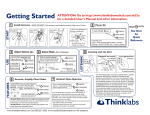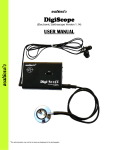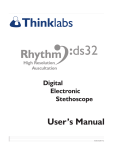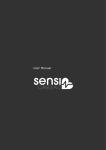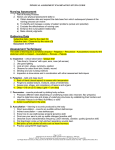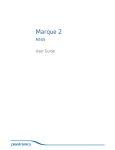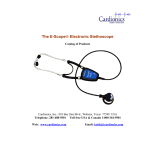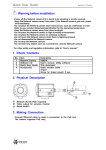Download Quickref ds32umqr v1-1
Transcript
Getting Started START 1 Install batteries. Slide open as shown Attention: See Reference CD-ROM for complete User’s Manual + Insert AAA battery. (a) Push cover DOWN into grooves to slide easily. a Insert AAA battery. + a BELL DIA DIA Push BELL key to switch between Bell and Diaphragm Mode. Green LEDs show Mode. BELL ZOOM DIA ZOOM Diaphragm Recommended starting level 5-7, then adjust to personal preference. 6 Push Acoustic Mode - for non-augmented sound. ZOOM key to switch between: Acoustic - Pre-set Volume, Blue LED OFF. Zoom - Adjustable Volume. Blue LED ON. Symbol Mnemonic: a Bell Curve looks like a Diaphragm Bell BELL DIA ZOOM 7 Sync - LISTENING VOLUME CONTROL behind keys 5 Select Mode - Bell or Diaphragm BELL Eartips face FORWARD Suggested key control Forefinger for Keys DIA ZOOM active when Blue LED ON Apply light but firm pressure. Left hand Thumb for Volume VOLUME CONTROL Acoustic Mode utilizes electronic signal processing to provide pre-set sound characteristics similar to a conventional acoustic stethoscope, but with enhanced signal quality. Zoom Mode provides signal processing augmentation with power boost and Adjustable Volume to “zoom in” on details. See Over for Quick Reference Listening with the ds32 S1 / S2 LED for cardiac cycle timing. Push key to activate. Red LED flashes on S1,S2, S1+S2. Push again to de-activate. DIA POWER OFF Device turns off after 120 secs or HOLD > LEDs > RELEASE closing, check step (a). 4 BELL ZOOM Do NOT Force. If not Adjust Volume Rhythm :ds32 b Daniel Smith USE 3 Power On PUSH & HOLD key until ALL LEDs light up, then RELEASE key. b (b) Slide closed. FEATURES 2 NOTE POLARITY. Push springs to seat batteries properly. Align cover & close. Hold Probe steady to reduce artifact. The EmD Diaphragm detects signals in the sub-sonic frequency range, to reproduce quiet low-frequency heart murmurs. Patient chest wall motion, or unsteady examiner hand motion, can induce large-amplitude subsonic vibrations. This can overload the detector and produce signal artifact or cutout. It is then helpful to hold the Probe so that the fingers holding the Probe also touch the patient chest wall (such as the left edge of the thumb and the fingertips in the above figure.) The Probe and chest wall then move in unison, with a consistent, light diaphragm pressure. © 2004 Thinklabs inc. Printed in USA. Sync - Probe location influences detection as follows: • Mitral/Apex - S1 usually detected over S2. • Tricuspid - S1 / S2 / Both possible. • Other areas - S1 usually detected over S2. See CD User’s Manual for details on the use of Sync. www.thinklabsmedical.com Call (303)521-5023 or [email protected] for assistance. Thinklabs Quick Reference Rhythm :ds32 See Over for Getting Started guide Display Sync Indicator (Red) Flashes on S1 / S2 Select Bell or Diaphragm Green LEDs show selection Sync Indicator LED - S1/S2 Cardiac Timing Push key to activate/deactivate (See Over and CD-ROM for details) Diaphragm Mode (Green) Control Panel Low Battery (Red) Change Batteries Bell Mode (Green) Rhythm :ds32 Volume Control behind Control Panel (active when Blue LED is On) BELL DIA ZOOM Zoom Mode (Blue) LED On - Volume is Adjustable LED Off - Volume is Pre-Set HIGH RESOLUTION Tips and Troubleshooting Tips for Best Sound Quality •Apply Probe with light, steady contact, not excessive pressure. (Step 5, See Over). •The ds32 works best with direct skin contact. Avoid using through clothing. •Experiment to find a preferred Volume level that optimizes clarity. •Load the Reference CD into a computer and READ the User’s Manual. The Manual contain USEFUL TIPS for obtaining best results. Troubleshooting • No Power: (a) Check batteries are inserted correctly. (Step 1, See Over). (b) Batteries need replacing. • No Sound: (a) Increase Volume setting. (b) Check headphone fit (See Over). • Unexpected interference sounds: (a) Radio station or electromagnetic pickup: Change position/location. (b) Continuous Buzzing: Diaphragm loose - tighten Diaphragm Ring. (c) Other noises: Possible dust, lint or moisture inside Probe Turn off device. In dust-free environment, unscrew Diaphragm ring. Wipe inside surface of diaphragm and sensor with an alcohol swab. Do not touch brass sensor plate or diaphragm with fingers. Allow to dry/evaporate naturally, then close unit. • Problem unsolved? Contact Thinklabs. See Over for contact information. © 2004 Thinklabs inc. ds32umqr v1.1 Printed in USA. Power On Push+Hold until all LEDs light then Release Power Off Shuts off after 120 seconds OR Push+Hold until all LEDs light then Release Zoom - Select Pre-Set or Adjustable Volume Push key to alternate between augmented Zoom mode and pre-set non-augmented Acoustic modes: Mode Zoom Blue LED Function ON Augmented ADJUSTABLE Volume to “zoom in” by increasing Volume. Acoustic OFF non-augmented PRE-SET Volume similar to acoustic stethoscope. See Reference CD-ROM for complete User’s Manual Thinklabs


